As mentioned in this post, during late summer and fall in this area there is a relative dearth of nectar available for our honeybees, as they depend heavily on native forage.
One of the best native nectar sources this time of year for honey bees is Coyote Brush (Baccharis pilularis), but our plants seemed to bloom much earlier than normal this season, perhaps due to our drought, and are now simply a mass of seeds.
That has left the honey bees with few foraging options while they prepare their colonies for winter, and we’ve been squarely in the midst of a nectar dearth since June!
As would be expected at this time of year, the majority of our native wildflowers are dormant. We have a few Encelia californica in bloom, which aren’t a bad pollen source, although relatively low on nectar, and the bees don’t seem to spend much time near these flowers.
The most nectar-rich flowers in abundance on the farm at the moment are the California Fuchsias (Epilobium canum).
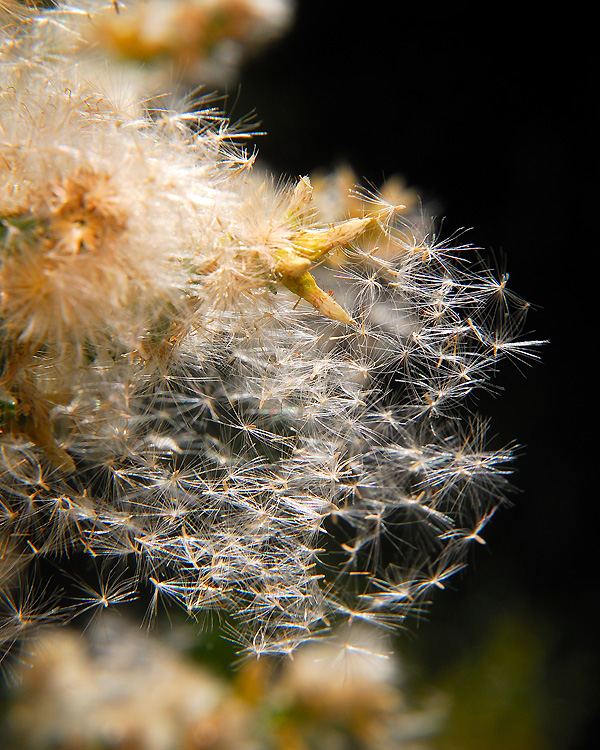
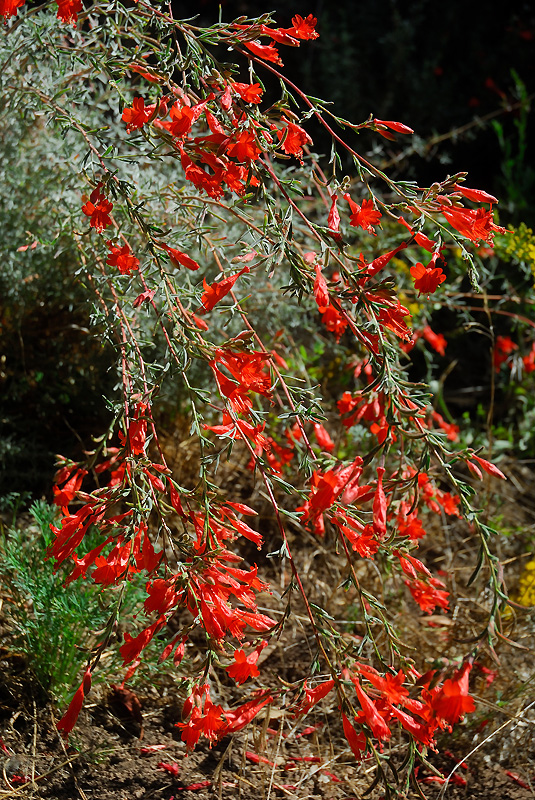
We maintain a few different cultivars of Epilobium on the farm, in part because they provide some welcome drifts of color on the slopes against the brown desiccated weeds and grasses at this time of year.
Typically, when people ask me about Epilobium, I mention that although the hummingbirds will happily forage among these flowers for nectar, they’re a poor nectar resource for our honey bees. The flowers are long, and tubular, and narrow toward the base, which makes it almost impossible for honey bees to exploit their nectar reserves.
Although the pollen is more readily accessible, as the pollen-bearing anthers of Epilobium are held beyond the petals, the honey bees don’t seem particularly interested in foraging for Epilobium pollen.
Even though Epilobiums produce nectar, honey bees are too large, and their tongues too short, to reach the nectary at the base of the flower. A problem for the bees, who have few nectar choices at the moment, but consider it from the flower’s perspective.
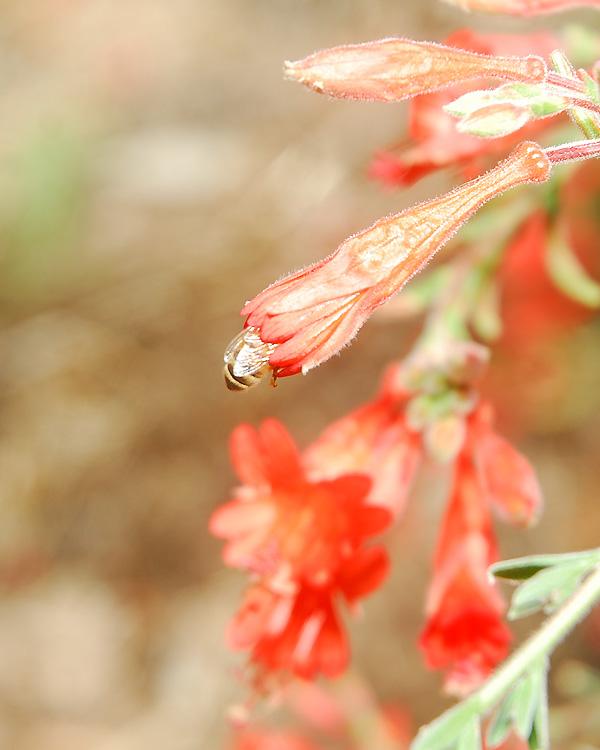

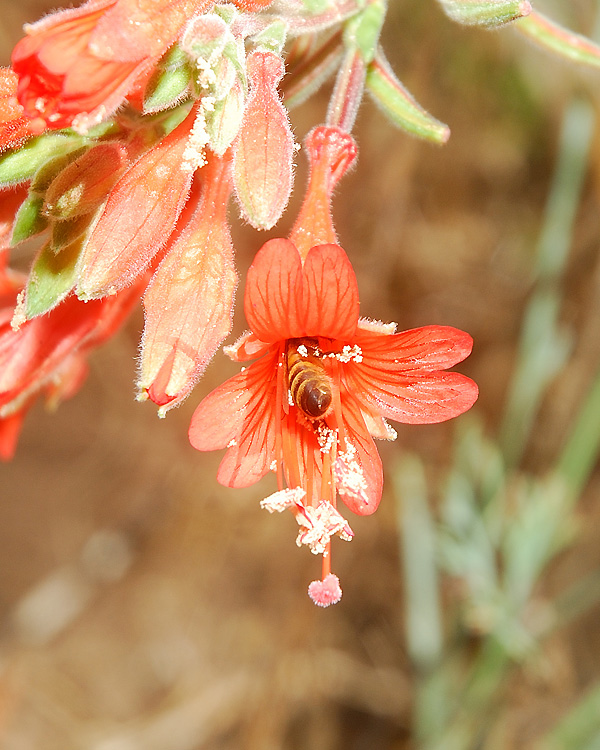
The Give and Take of Pollination
Nectar in flowers attracts insects, and provides a reward for those that forage on them. To reach the nectary, insects visiting these flowers typically have to brush past the pollen to reach the nectary, and the pollen grains are then transferred to other flowers as the insects move about. Pollinators, like bees, don’t pollinate flowers because they want to. Pollination is more incidental, than intentional, as bees and other insects travel from flower to flower in search of nectar as food.
Until yesterday, I haven’t really noticed honey bees giving our Epilobiums so much as a second thought. However, while photographing some native Goldenrod (Solidago californica) flowers this week, I noticed an absurd number of honey bees hovering around the Epilobiums, which seemed rather odd.
As I wasn’t expecting to see much honey bee activity in the vicinity of the Epilobiums, I watched more closely for a few minutes. I saw quite a few bees diving head first into the flowers, backing out, and flying on to the next one.

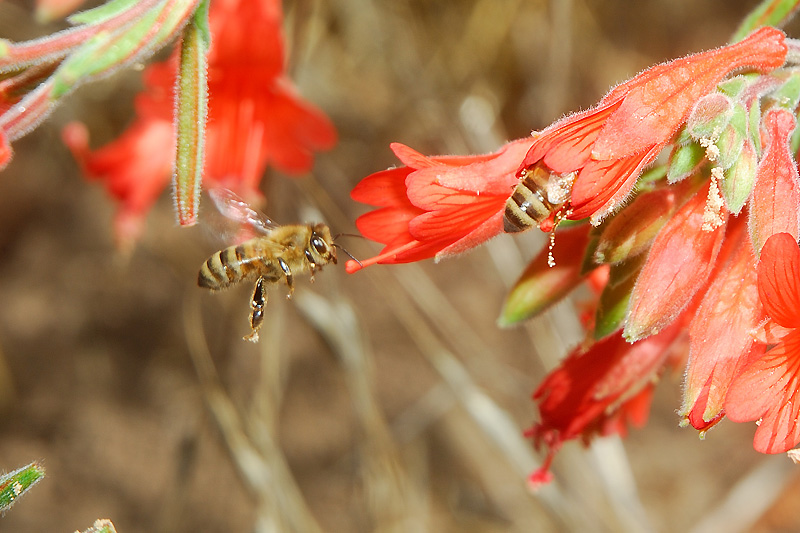

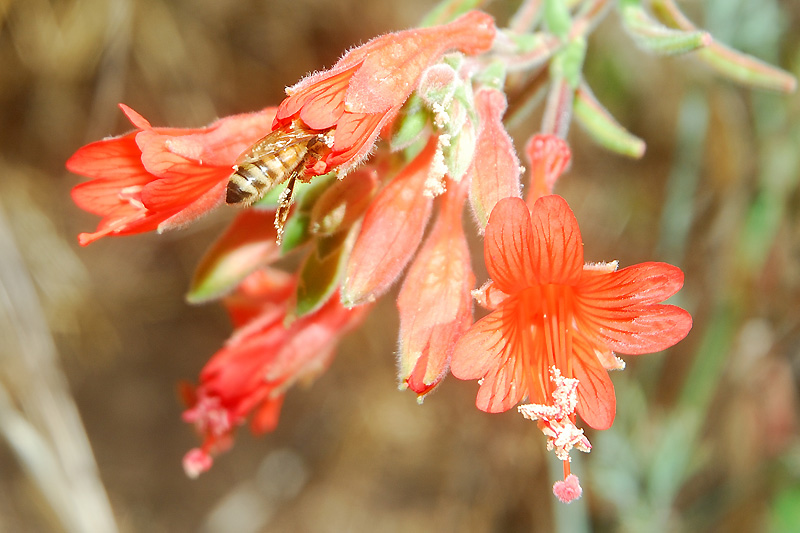
They were dragging pollen around, and pollinating the flowers, but it was questionable whether or not they were really succeeding in obtaining a nectar reward at all. Note that these bees clearly weren’t gathering pollen, as their pollen baskets were empty.
I could only assume that these bees knew the nectar was there, but had no idea how to reach it.
Engaging in Bad Bee-havior
Some of the bees clearly had figured out how to reach the nectar though. Following the bees between the flowers, a number of them were observed targeting the base of the flower, externally. Through a macro lens it became obvious that these bees were exploiting the nectar reserves through small cuts and slits at the base of the flower, which exposed the nectar.
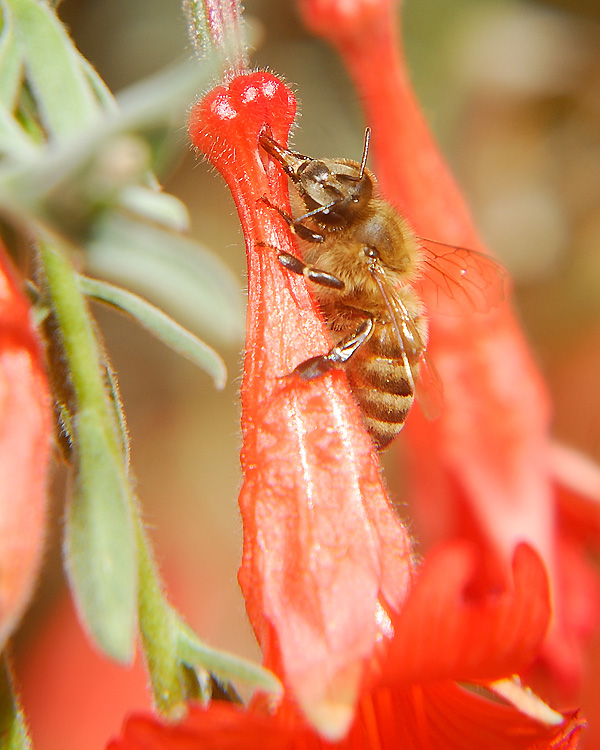

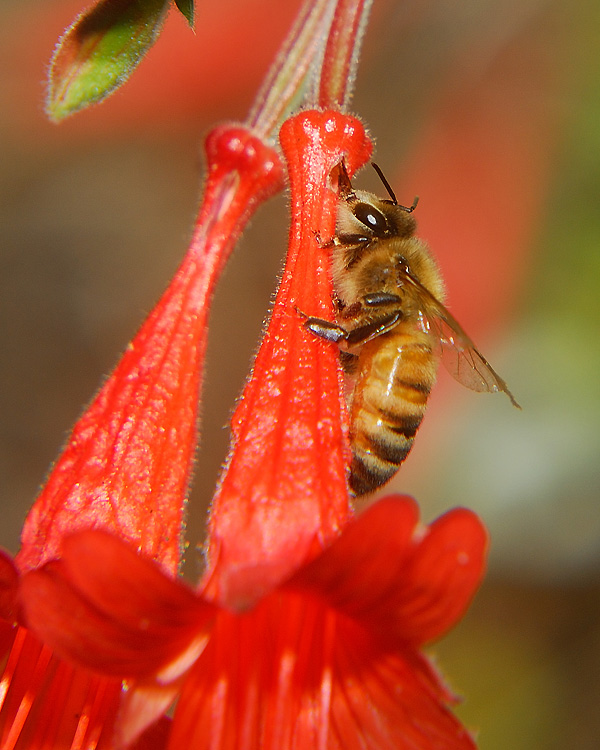
Is Robbing Necessarily A Crime?
Pollination of flowers by bees is generally considered to be mutualistic. To successfully reproduce, flowers need to transfer pollen to another flower of its kind. For wind-pollinated, self-compatible flowers, this isn’t as much of an issue, but flowers that depend on insects for pollination encourage pollination by offering the insects a nectar reward. In this scenario, both the flower, and the pollinator, gain something from the exchange. The flower can successfully transfer its pollen to reproduce, and the pollinator receives food in exchange. It’s a mutually beneficial arrangement.
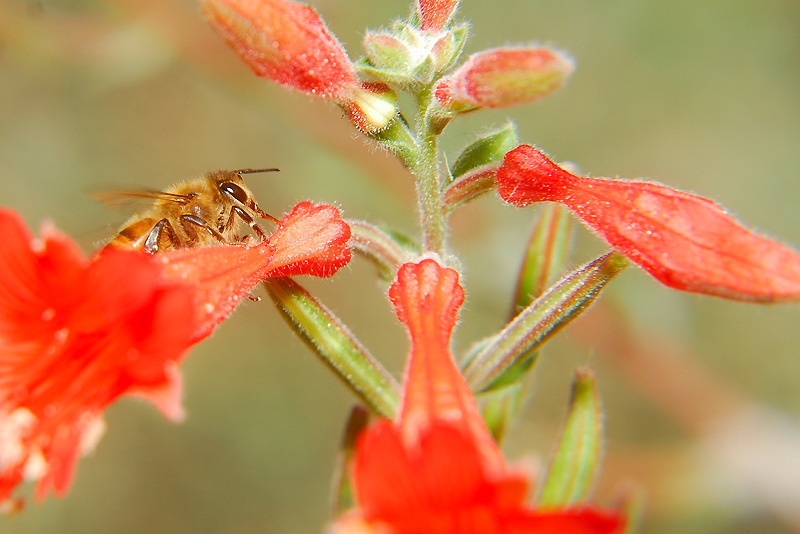
However, the shape of the flower may restrict the types of pollinators that can access the nectary to receive the reward. The nectaries in narrow, tubular-shaped flowers, like Epilobiums, are most easily accessed by small insects, or long-tongued bees (and long-tongued hummingbirds of course). Honey bees are quite large, and have short tongues, and are not well suited to pollinating these narrow, tubular, flowers.
These nectaries contained in the Epilobium flowers are essentially in a locked safe, and without the right combination (narrow body, and/or a long tongue), the nectar remains secured within that safe. However, some bees, like bumble bees, are masters at safe-cracking, and able to cut a hole in the side of these secure vaults just large enough to liberate the nectar within.
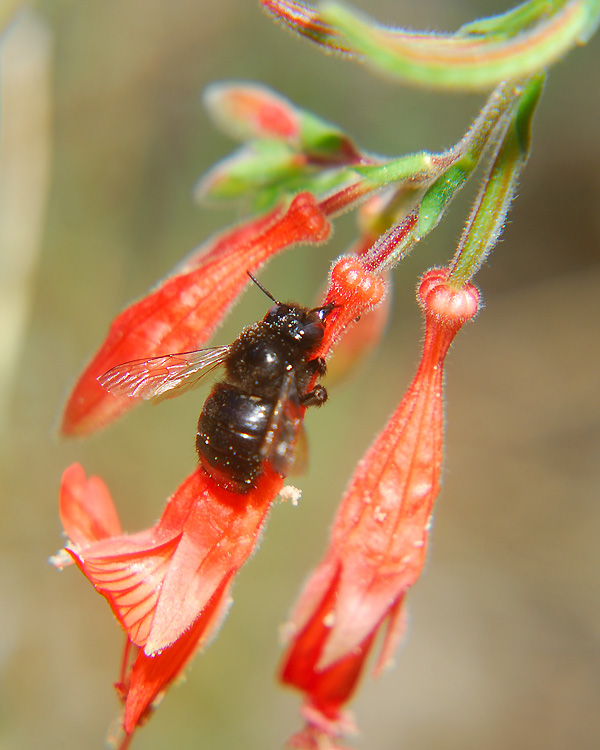
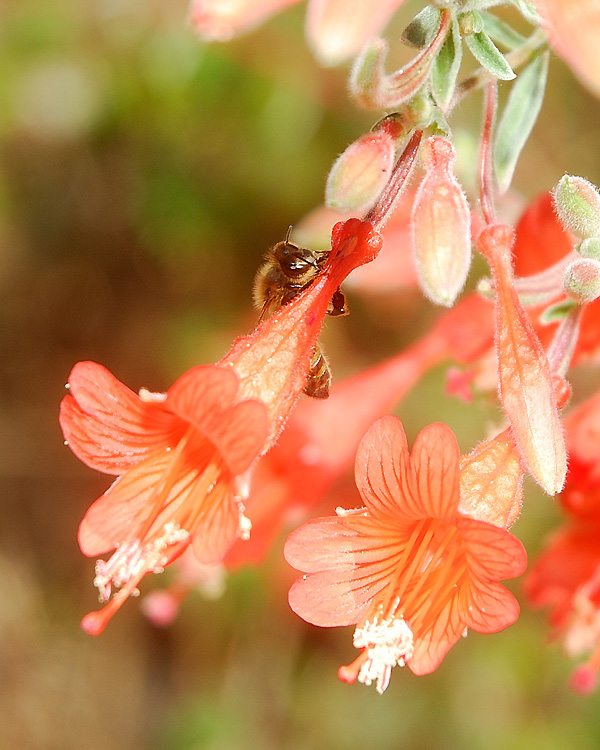
Although these honey bees were raiding these exposed nectaries, it’s not likely that they were the original vault robbers. When it comes to robbing nectaries, there are typically primary robbers, like bumble bees, that can chew holes into the petals to reach the nectar, and then secondary, opportunistic robbers, like the honey bees, that are simply looting the now opened vault, to exploit the treasure within.
As a result of this behavior the contract between flower, and pollinator, has been broken, as these bees are now stealing the ‘reward’, without providing pollination services in exchange.
However, at least half of the photographs I took of these honey bees among the Epilobiums show pollen-coated bees diving head first into the flowers. Pollen is still being transferred, albeit accidentally, from flower to flower.
Recent studies in bumble bees have shown that this type of robbing behavior may actually be learned, rather than innate. [1]
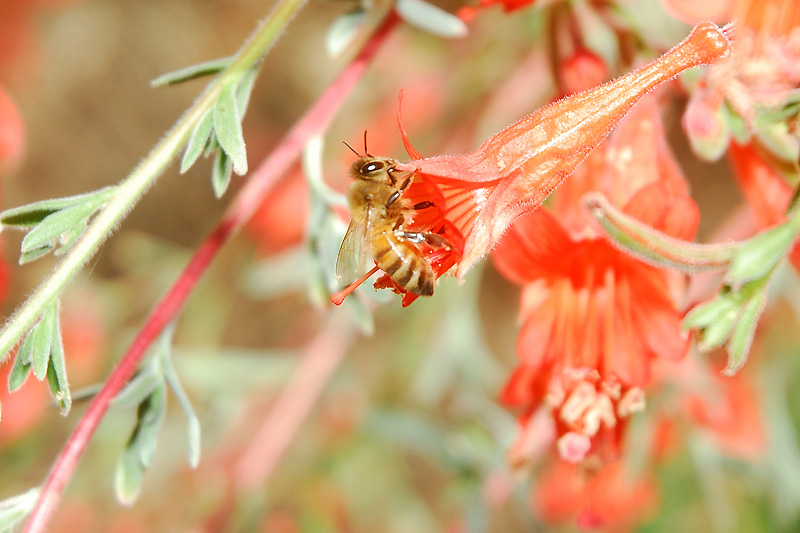
I’m not sure if the same is true of honey bees or not, however, watching these honey bees one could assume that those bees entering the flowers from the front might be new field workers from the colony, and that in an effort to reach the nectar, albeit unsuccessfully, perhaps they have not yet ‘learned’ how to reach the nectar at the opposite end of the flower.
Those that are successful in robbing the nectaries seemed to travel directly from one nectary to the next, they weren’t even bothering with the front of the flowers.
Others were clearly entering the flowers, and responsible for at least some degree of pollination occurring. Pollination efficiency is clearly not optimal, in that not all bees are entering the flowers from the front, but pollination is likely occurring nonetheless.

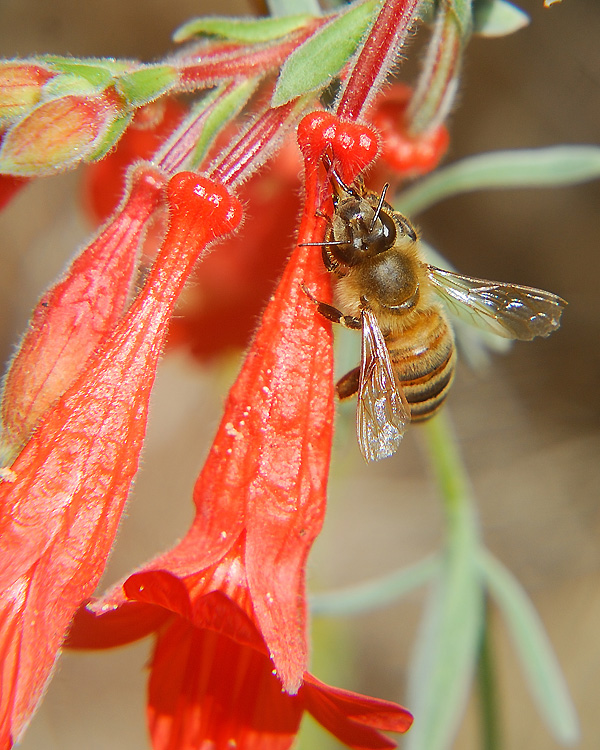
So although the robbing bees are cheating the system, some of them are moving pollen between the flowers without the benefit of a reward, perhaps reducing the level of the crime committed by these nectar-thieving honey bees to the level of a misdemeanor, instead of a felony. Besides, as the bumble bees were likely there first, these honey bees are merely an accessory to the original crime.
That said, there’s an element of risk to a honey bee that chooses a life of crime, especially at this time of year. While they’re busy robbing the Epilobiums of their nectar, squarely in the center of one large plant, I found a large female Banded Garden Spider (Argiope trifasciata), and one nectar robber that clearly didn’t make it back to the hive alive!
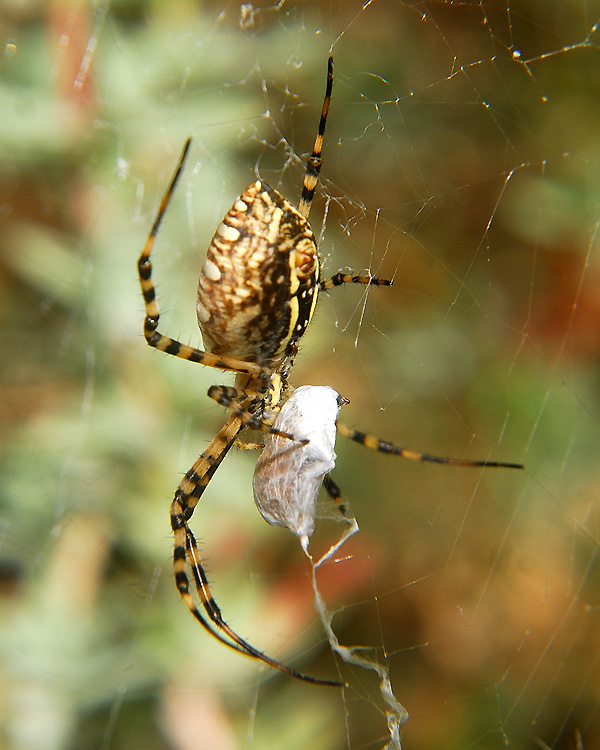
—————–
[1] Leadbeater, E., and Chittka, E. Social transmission of nectar-robbing behaviour in bumble-bees. Proc Biol Sci. 2008 July 22; 275(1643): 1669–1674.

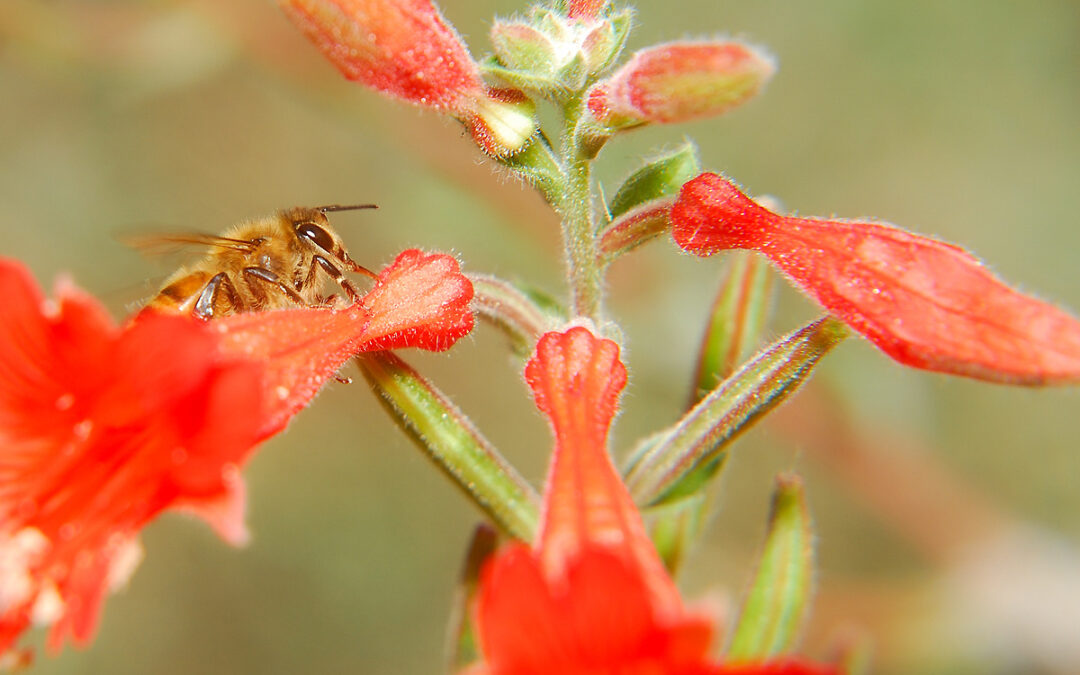

Slits — wonderful! I’ve seen bees getting nectar from the base of blooms before, but always assumed there were natural “leaks” that they’ve found. I’ll have to look more closely in the future.
Fantastic photos!
I’ve watched the bees cheat on other flowers too, although I’m not sure their method of stealing nectar from a nectary is necessarily always the same. I do think flower structure may play a role too.
Still, I find that honey bee robbing nectar after bumble bees have created these portholes to be quite fascinating. I do wonder if the honeybees would ignore these flowers if there were no bumble bees to expose the nectaries for them?
I’ve seen those slits at the base of Tecoma flowers.
latest post?
Ah, yes, I see your Tecoma flowers are very similar. Long, narrow, and tubular. I can just envision all of us gardeners running around now with a magnifying glass, scrutinizing our tubular blossoms for holes! 😉
This is fascinating, Clare. Now I’m going to have to pay more attention to exactly what the bees in my garden are up to!
I’ve had this affliction since I was a small child. I could just sit and watch small creatures in the garden for hours. Of course, these days I don’t have as much free time, but it is interesting what you can see when you slow down for a few minutes, and watch. If I hadn’t taken these few minutes to see what these bees were up to, I never would have known that they were successfully gathering nectar from these flowers! 🙂
Huh! I’m going to have to look a little closer at some of my tubular flowers. Great macros and great information!
I’m trying think about what tubular flowers I have, other than salvias, that bloom in the spring, when more of the bumble bees are around. I’m not really seeing any Yellow-faced Bumblebees this late in the season, just Carpenter Bees. I suspect those are our primary safe-cracking bumble bee here at the moment, but I’d curious to see if others employ this same technique to break into the nectaries!
I just saw a researcher describe how yellow-faced bumble bees (Bombus vosnesenskii) take pollen from a variety of flower sources in order to balance their efficiency (visit flowers from which large amounts of pollen can be easily obtained) with nutrition (good balance of amino acids and protein). The bees would vary their diet throughout the season and from place to place in order to obtain this balance. She suggested this indicates that ecological restoration sites (and native plant gardening) best benefit the pollinators by planting a variety of plants. Even though pollen is for bee larvae and nectar is for bee adults, they may be similarly balancing their nectar diet. http://www.nature.com/news/2011/111109/full/479164a.html
Glad you stopped by, Cindy. Love your blog! 🙂
Interesting article, too. Not necessarily surprising results though. As beekeepers one subject that’s been receiving a lot of attention in the bee-keeping community, is nutrition, and the importance of quality, diverse, and uncontaminated pollen sources.
As we struggle with weak colonies, novel parasites, and infections in our bees, it’s become abundantly clear that the classical management of honey bee colonies is the worst thing a beekeeper could do.
We’ve be striving since adding bees to the farm to provide a diverse population of plants that bloom throughout the season here. Native plants when possible, and well-behaved, non-invasive non-natives as well. We’re still short on good nectar producing, honey bee-friendly, plants in the fall though.
Pollen tends to be in relative abundance here in the late summer, as many of the Asteraceae are in bloom in the late season, but nectar tends to be the limiting resource until we push deeper into winter. One of the best winter nectar sources here is the Eucalyptus that many have a love-hate relationship with.
I’m not sure if the honey bees are balancing their nectar diet, per se, or simply trying to source nectar anywhere they can find it at the moment. We’ve been propping up our colonies for the last few months, with supplemental feeding, as our hives are so light on nectar and honey with the drought this year 🙁
Very interesting! I’ve noticed this nectar robbing behavior by our Carpenter bees and syrphid flies in the garden. Are California fuchsia native to your particular area,…there must be a way they would naturally be able to reproduce in spite of the ‘robbers’. I’d give ’em a pass for mere cleverness.
Similar to your goldenrod in flower shape and color is our endemic Golden Fleece, Ericameria arborescens, in full bloom now and FULL of honey bees!
California fuchsias are native to this region. I believe there are reports in CalFlora from both Big Basin and Castle Rock State Parks.
I’m sure the hummingbirds do a lot for pollination efficiency for this plant genus. Our Anna’s hummingbirds are very active at the moment, and they’ll spend a lot of time going from flower to flower. A lot of our small native bees (Ceratina sp., Agapostemon sp., etc.) may be small enough to reach the nectaries conventionally. Honey bees are comparatively rather rotund, so they’ve had to be a little more creative.
I do wonder though if honey bees ever directly employ the method of cutting holes in petals to reach nectar though. As beekeepers, we know all too well that honey bees are perfectly capable of chewing through wood, so it seems petals wouldn’t be that challenging. That said, I expect field workers, for efficiency sake, would likely take the path of least resistance, and most reward, while foraging. So even though they could do it, I wonder if they actually ever bother. I do love this sort of dependent relationship they have with the bumble bees though. Very resourceful!
I thought about planting Golden Fleece (Ericameria arborescens) here, but never got around to it. Did you start with transplants, or seed? Do they self sow well? It is native to this area too, although I’m not sure I’ve noticed any near here.
I am so amazed at how you get these incredible shots…fabulous.
Well, I do have to get up in the bee’s business, but they don’t seem to mind, too much. Macro filter, and moving slooooooowly with the camera already up to my eye, so I don’t make any sudden moves. Now, if I could just get that method to work for butterflies. I am so bad at photographing butterflies! 😉
Smart bees! It sounds like a learned behavior, and I admire their industrious nature and determination to reach the nectar, especially when their nectar sources are limited. I suspect the flowers will be pollinated anyway, as you note those who haven’t yet learned they can’t reach the nectar by entering head first. It all works out.
I think so too. Perhaps not optimal pollination, but overall, no harm, no foul. The job gets done in the end, and everyone is happy. We do also encourage our native pollinators too, including some very tiny bees, who no doubt help to fill in the pollination gap 🙂
Fascinating post, thank you! Do you know for sure that the honey bees didn’t chew the slits, rather than bumble bees? Think I’ve read about cases of honey bees chewing holes to reach nectar through.
I can’t say with 100% certainty that the honey bees didn’t make the holes, but those who have studied this behavior much more closely than myself have documented the relationship between carpenter bees and honey bees very well when it comes to robbing.
Honey bees are usually considered to be the secondary robbers. Although honey bees can chew through wood and paper, it would be far less efficient for them to take the time to drill through the flowers themselves, especially when the bumble bees are already doing the work for them. There were Carpenter bees among the Epilobium flowers too, so I know they’re there.
I did read another interesting article in regards to these slits made by the carpenter bees, in that these bees have a handedness of sorts. An individual bee tends to always make a slit on the same side of the flower. Some of the flowers only had slits on the right. Others only on the left, and others had two slits on the same flower 🙂
Very smart of the bees, and I suppose as long as there are some that dive into the flower and pollinate it, no harm is done. I have not seen this in my garden, but I have to admit to not looking that closely. I didn’t realize that honeybees would do this, but perhaps the lack of food in your drought is making them become more resourceful than usual.
I honestly don’t know if the bees have been more motivated to engage in robbing behavior this fall, or if I just simply missed this behavior in the garden in previous seasons. That said, this is the first year that the Epilobiums have bloomed this much. They were only planted a couple of seasons ago, and this year there are thousands of blooms across the slope, so certainly more opportunity for robbing from these flowers this year. I’ll definitely be watching for it next season though. I’d love to catch a bumble or carpenter bee in the process of making the initial access hole to the nectary! 🙂
Hi Clare,
I’ve seen this behaviour on a few plants before – the one that springs to mind are Dicentra blooms. The bees always try to get to them but can’t so they often end up with holes ripped in their tops like this. I always assumed it was when a certain species couldn’t reach the nectar i.e. some have long tongues, other short.
It does look like enough pollination will be happening, especially considering Moths and flies will also be helping the process along.
That’s interesting. I don’t grow much Dicentra here, so haven’t thought to look. I do see holes ripped in our Calochortus blooms each year, but those are quite large, and circular, and I’m presuming those were made by leaf-cutter type bees. You’re right, there are a number of other insects, beyond our honey bees, that will also be contributing to pollination. I know some of our native bees are small enough to pursue the nectar in a more conventional manner! 😉
Interesting that this is learned behaviour. Bees deserve a lot more credit than we give them I think. I expect the lack of flowering plants has been a strong push for them to ‘learn’ this behaviour (if they weren’t doing it already).
We’ve been beekeepers for a few years now, and honestly, I’m still waiting for the hive inspection were I don’t see, or learn, something new. I honestly find these creatures to be endlessly fascinating. In our rip-roaring hives I always find it amazing that anarchy doesn’t ensue! Somehow, even in the presence of large population, there is always order, and purpose, for every bee contained within the colony. It’s difficult not to be in awe. And as for intelligence, well, they excel there too! 😀